#my art and coloring style are so drastically different from when i started this [March.] that i am never finishing this.
Explore tagged Tumblr posts
Text



im never finishing this comic so woe. blue lock rpf be upon ye
#my art and coloring style are so drastically different from when i started this [March.] that i am never finishing this.#anyway my favorite bit is blue lock rpf. unfortunately because blue lock is a fictional series we will never get the same level of fic as#they're getting in universe i know it#blue lock#blue lock fanart#isagi yoichi#bachira meguru#hiori yo#chigiri hyouma#mikage reo#im not tagging everyone.#omegaverse#<- for filtering purposes.#my art
133 notes
·
View notes
Photo
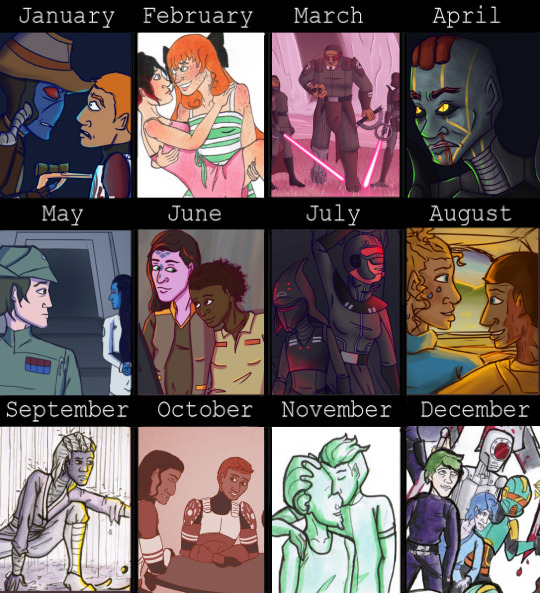
ID: A grid with boxes labelled for each of the 12 months, with a drawing from that month in each of the boxes.
I feel like I have to add an addendum for this year because obviously, everyone's lives changed drastically and that affects the mood of the art and the artist. I got the "lack of time and motivation" end of the stick, and while I sometimes tend toward self-deprecation for this, and it's weird to see my art sort of "regress" (less fancy lighting, ambitious poses, etc.), so I'm going to take a moment to be proud of the fact that I've learned how bodies work in space better, how to more seamlessly slot two people in a picture again as opposed to it being out of place, I've gotten better at working on the head from different perspectives and action shots, and most of all, I'm still growing, despite all of this.
Thoughts about individual months under the cut:
January: I realized that, even though I branded myself with clone content originally, it'd been a while since I...drew any of the clones. I decided to change that for a short burst in January, and this is probably my favorite of the bunch: I love the vibes, tension, and me adding a highlight for the hell of it (even if the light source is a bit inconsistent). February: I drew a lot this month but I figured I'd be remiss if I didn't put at least one rwby-related piece in here. I think this is the best Penny I've drawn, but still need to work on Ruby. Either way, Nuts and Dolts won this year! March: Bar none the piece I'm the most proud of this year—I worked with a pretty intense pink palette and the fun of working that into the usually black armor as well as the background. Also, the slightly tilted up perspective was a beast, and I had to trace and then reference my own tracing in order to create something that was still consistent with my style, but I did it! I think this was the transition into what I wanted the trajectory to be for this year, and in a way, I sort of kept that going with realizing how limbs work in a space. Also, create the obscure inquisitor content you want to see in this world. April: I finally settled on a face for Eighth that I really enjoy, and also I came into my own with the beginnings of digital painting. Also, more highlights for the hell of it, which I love and will continue to incorporate into as much as I can. May: I did a few fun couple shots in May, but this one was my favorite because during this and April, I learned that I could do backgrounds without putting maximum effort into it but still add depth and interest to a space. June: I did neekaz at sunrise so tamnara at sunset felt appropriate. I got to expand on their character design and am finally starting to get better at making people organically fit together. Also, the easter egg in the image is that Synara's wearing Tam's bandana around her leg, and Tam's wearing Synara's necklace. July: I wasn't initially super proud of this when I first drew it, but audience reception helped me realize it was a step for me—once again going with the theme of having fun with lighting and relying on the lightsabers to cast light for the image. Also, create the content for obscure inquisitor duos you want to see in the world. August: Even though I'm not as into it anymore, I feel like these would feel naked without some sort of ags material on the list, so I decided to have Alex and Zee live out my fantasy of waking up next to your partner/best friend in a tent and enjoying the sunrise together. September: This month started the mother of all art block which has lasted up until this point, and also w*rk got really busy. Either way, I did make something I was proud of this month, for Voe Starwars who absolutely deserves both the world and more canon material. I like the sense of dynamic movement and the actually doing a simple background with markers! This is also probably one of my favorites from the year. October: This was also...something. I redrew an old piece because my motivation was at a low, but I ended up enjoying both it and the noise filter which I applied on top. My cycle this month though was pretty much I came home and slept though, so honestly? Still proud. November: Once again was barely able to muster the motivation to draw, so this is an art ask game, but I love the simplicity of duo-toned markers to color something. It makes it feel more polished than it is. December: I drew all of one finished thing this month. Granted, it was 23 whole characters in different positions, lined and colored in so I'm proud of that! I mostly drew this just so I could get out some concepts which all deserved their fully-finished glory, but I didn't dredge up the wherewithal to do, so I at least did something.
10 notes
·
View notes
Link
The life of a teenaged superhero is never easy, but it’s about to get a lot harder for the young vigilantes of the Marvel Universe. March’s Outlawed one-shot introduces a new status quo that has the government cracking down on superheroes under the age of 21, and these events will have repercussions across the publisher’s entire line. Written by Eve L. Ewing with art by Kim Jacinto, colorist Espen Grundetjern, and letterer Clayton Cowles, Outlawed sees the country rocked by a tragedy involving the Champions that compels politicians to take drastic actions. The set-up is reminiscent of 2006’s Civil War, which similarly began with a tragedy surrounding a young superhero team leading to federal restrictions on superheroes.
“Civil War was meant to be (among other things) about curtailing personal liberties in the name of safety,” says Outlawed editor Alanna Smith. “Outlawed is tapping into different social anxieties. There’s been a lot of debate lately about the role of the youth in our society—whether they should partake in activism, how much their voices should be valued, whether they’re old and learned enough to have a say in their future, and what responsibility the older generations have to keep them safe. When you boil it down, Outlawed is about the conflict that arises when widespread decisions that affect an entire generation are made by people outside that generation, while ignoring the input of people who will have to live with those decisions. In this case, there are real, heartfelt concerns on both sides of the conflict that make it that much more complicated for our heroes to overcome. It’s not a problem they can punch.”
“To me, this story isn’t just about young people being in conflict with the government, but much bigger questions about what we ask of young people, how they’re expected to be independent sometimes and subservient other times,” says Ewing. “Every era of history brings new challenges, and young people today are coming of age in the era of mass shootings, the era of the climate crisis—things that in some ways are unprecedented in history. Yet we often don’t recognize their wisdom and their insights. It’s like we get above a certain age and lose all empathy. I just wanted to explore that tension, and them being superheroes really ups the stakes because they’re literally out there saving lives every day, but aren’t seen as full people or full citizens. And, at the same time, maybe the law is a good idea? Maybe it really is for everyone’s protection? It’s intentionally kind of morally ambiguous.”
“Eve is really skilled at getting into the psyche of our younger characters without pulling punches,” says Smith. “Her run on Ironheart had a really dark undercurrent of coping with loss and self-doubt that elevated it beyond what I think people expected. Outlawed needed someone who could write about kids dealing with a world that’s turned against them and make it feel visceral and real and urgent. She brought that intensity, and she’s also incredible at capturing the charm and personality that has made these characters so beloved in recent years.”
“I feel really grateful that the editorial team saw how much I enjoy writing adolescent characters and decided to give me this opportunity,” says Ewing. “I used to teach middle school, and as a teenager myself I was really angsty and dramatic but also, I think, had a lot of genuine emotional and intellectual perspectives, as all young people do. So I’ve tried to bring those experiences to bear in the way I wrote Ironheart, and the way I wrote Spider-Man and the Unstoppable Wasp when they paid a visit to the Ironheart world, and with Marvel Team-Up I got to really explore questions about what it means to be an adolescent because in that story, not only was I writing Ms. Marvel, but Kamala and Peter Parker actually switched bodies. So Peter had to remember what it was like to be a teenager. In a sense, I’ve kind of been in his shoes, putting myself in the head of a 15- or 16-year-old and trying to make sense of what it’s like in there, with real respect and care. So I’m excited to keep flexing that muscle.”
“When we first started talking about this story I was really excited about it from a character perspective, because I love the Champions, I love what Mark Waid and Jim Zub and Grek Pak and Jeremy Whitley and Saladin Ahmed have done with these characters individually and as a team,” says Ewing. “And I was also really excited about it from a sociological perspective, because I think the story presents some big questions about young people and politics and society and citizenship and government control and surveillance and what we think of as safety. All of that. But I did not anticipate that the powers that be would want to make this into a more far-reaching story that will really ripple across the MU. So I’m very humbled by that and definitely working up my nerves to just try to tell a good story that’s worthy of all that.”
This exclusive first look at Outlawed #1 highlights the complicated ethical dynamics at the core of this story, showing the perspectives of both adult and teen heroes. Jacinto’s dramatic body language and Grundetjern’s bold color palette charges these talking heads with emotion and urgency, and the final page of this excerpt highlights how well they capture heroes in action. “Kim’s style has evolved in really dynamic and exciting ways in the past few years,” says Smith. “I wanted someone who could draw intense, visceral action and also someone who would make our younger characters look like total badasses, and Kim delivered on all fronts. He’s got flair, and this is a book that needed flair. We’ve also got Espen Grundetjern killing it on colors, and longtime Champions mainstay Clayton Cowles on lettering, so you’re going to want to feast your eyes on these pages!”
Jacinto’s artwork has gone through some significant shifts over the years, and he has a talent for adjusting his style to match the tone of his projects. “I’m trying a different approach on this book,” says Jacinto. “My taste typically leans towards a dark and gritty style so I changed it a bit and I’m experimenting on this book. Since most of the characters are young superheroes, I wanted to give the characters more energy and dynamic poses. This book made me explore new ideas and go out my comfort zone and that excites me the most. Eve is very easy and fun to work with and straightforward. She will tell you if something is off and that makes it easy.”
“We’re bringing the next generation of heroes to the forefront in a major way and swinging for the fences in terms of story, stakes and scale,” says Smith. “Outlawed introduces an ongoing status quo that will be reflected in books across the line—almost every active character who’s under 21 (and even a few who are older) will be affected by the decisions made in Outlawed, and they won’t all agree on whether the new world order is good or bad. But there are real, serious consequences now for those who go against the ruling passed down in Outlawed, and it’ll interfere with their lives in a way they’ve never experienced, leading to some really interesting stories.”
58 notes
·
View notes
Text
The September Vogue Mood Report
Don’t shoot the messenger.
For the second year in a row, Vogue has turned political and I must discuss it in order to do an accurate mood report. I dislike politics and rarely discuss the subject, so for the second year this was not a fun report to write.
I was so saddened by last year’s issue that I barely spent any time on it, focusing mainly on the cover which I labeled “Sunset Of Liberty.”

If it’s true that “Democracy Dies In Darkness,” I very much wanted to be wrong, but it does not appear so. Not with the emergence of Shadow Banning and Search Engine Manipulation against political opponents, or land confiscation in South Africa based on skin color (which, like Europe’s Migrant Rape Crisis, is deemed racist to even discuss).
Shadow Banning and Search Engine Manipulation is repugnant to a free society. It is otherwise known as censorship.
This year I’ve left emotions at the door and have instead followed the rabbit hole. My job is not to judge. My job is to analyze content through the lens of social mood . . . while it’s still permissible to do so.
On second look, it turns out that there was a familiar political theme in 2017 that morphed into this year’s edition.
This year seemed to be a consistent strategy of repetitive political talking points.
This is important to be aware of because whether it’s propaganda, advertising, or politics, the strategy is always the same: repetition.
Messaging and persuasion is achieved through repetition.
Keep repeating it and it sticks.
Get it?
It’s an insidious process if you’re not paying attention. It’s happened to me. During my tenure at Condé Nast reading over two dozen magazines cover-to-cover each month because my job required it, my sensibilities were drastically altered. I didn’t notice it until I left the city and my new attitudes were wildly apocryphal, quite incompatible with real life. It was bizarre how subtly it occurred.
“I love journalism. My dad was an editor, my brother is a political editor, it is just a world that I am steeped in.“
~ Anna Wintour
It is not a conspiracy theory to illustrate Anna Wintour’s connection to politics.
In 2008 she was appointed to the Order of the British Empire.
In October 2009, President Obama appointed her to the President’s Committee on the Arts and Humanities.
In 2011 she was awarded the Legion d’Honneur by French President Nicolas Sarkozy.
In 2013 she was named Artistic Director of Condé Nast.
In October 2016, Vogue made its first political endorsement in its 124-year-history, calling Hillary Clinton “optimistic, forward-looking, and modern.” (Remember that word “forward.”)
In 2017, for her service to British journalism and fashion, she was named Dame Commander (DBE) of the Order of the British Empire by Queen Elizabeth II.
With her new role as Artistic Director, Dame Anna Wintour now controls the editorial vision not only for Vogue, but every title published by its parent company, Condé Nast.

Wintour is therefore at the nucleus of powerful ecosystem that intersects with a vast array of companies and, according to The Business Of Fashion, operates as an “unofficial, behind-the-scenes consultant to CEOs, designers, politicians and movie stars in America and beyond.”
“Wintour is indeed more like a head of state than a mere editor-in-chief, a position which gives her a unique, bird’s-eye view of the fashion industry, emanating outwards from Vogue and Condé Nast to the wider ecosystem that sustains this $2.4 trillion industry.”
~ The Business Of Fashion
In short, she is in a position to sway millions of opinions and trillions of dollars. And with a keen eye for politics and a nose for power, she’s taking advantage of it.
“One of the initiatives I have here in my role as artistic director is that I have regular Editorial Task Force meetings, or ETFs, where we invite leaders from other worlds to come in and talk to the editors-in-chief and the digital leaders and a few other people about what they see happening in their industries, whether it be media or Silicon Valley — we pull them from everywhere.”
~ Anna Wintour
Yet even if there was a deliberate political messaging strategy at work in this year’s September Vogue, the message itself is largely irrelevant for this analysis.
Yes, irrelevant.
Instead, the task for Mood Report is to answer the larger question: What does it mean when the world’s preeminent fashion magazine indulges in political messaging in the first place?
Is Vogue, to use a word of the moment, colluding with others to project a unified voice?
Or, is Vogue simply reflecting (caught up in) a social mood extreme, much like when a non-financial publication such as Time magazine features the stock market on its cover? At such times the trend in focus may be ending just as it’s being celebrated (or denigrated).
The originator of the Magazine Cover Indicator, the late Paul Macrae Montgomery, reviewed 3,000 magazine covers and found an 80% probability that if there was an investment related story on the cover of a non-financial magazine such as Time, Life, Newsweek, etc. that within three to four months the market would move in the opposite direction of that suggested on the cover.
For example, November 2, 1987, just days after Black Monday, and yet the market hasn’t looked back since:
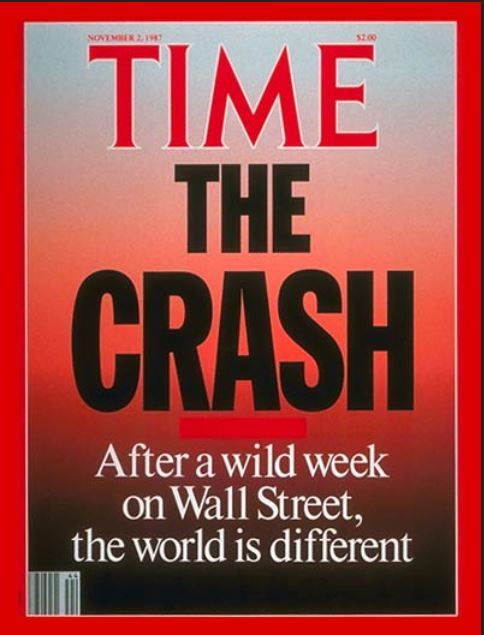
June 13, 2005, Home $weet Home, right before the peak of the housing market:

Or this one just recently. Highly unlikely that The September Issue is dead, but with readership and ad revenues down, perhaps a stern warning regarding the current editorial direction:
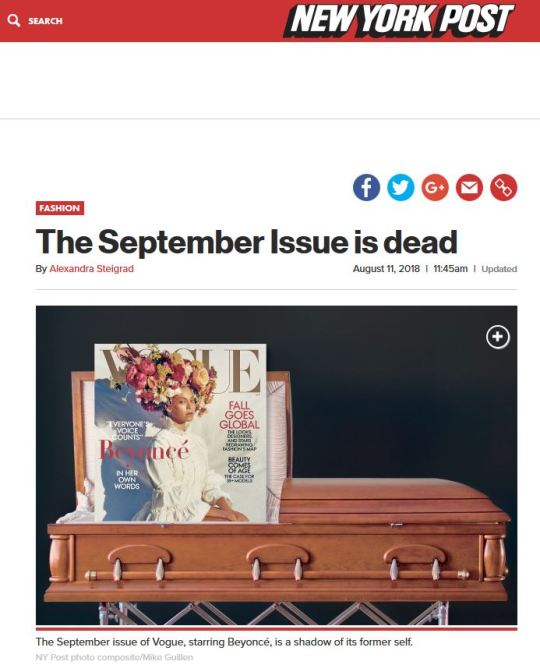
What might appear as editorial collusion might simply be like-minded people seeking to be “Stronger Together” (to use a slogan from 2016) as a form of political resistance.
In other words: a herding impulse.
During times of extreme polarization and uncertainty, people naturally seek to align themselves with others of similar persuasion while being certain of only what they’re against. Repeating the same phrases and points has the comforting benefit of reflecting back their own beliefs which adds confidence and reassurance.
As political ideologies spread further apart, the effort to message one’s viewpoint takes on greater importance, even if it means filling the world’s most iconic fashion magazine with political talking points from cover to cover.
Again, the intent is not to judge the politics but to analyze the mood. By getting the “mood” right we can predict the politics. That is why, from a social mood standpoint, the outcome of the 2016 US presidential election was to be expected.
It is quite likely that the current polarization results in part from a monetary extreme: unprecedented stimulus and accommodation by like-minded central banks also seeking to be “Stronger Together.”
“The IMF was part of rebuilding the global economy — we all cooperated in the same endeavor: Rescue the system. That system was severely tested at the beginning of 2008. And that system was rescued and improved thanks to international cooperation, thanks to the belief that we could be stronger together.”
~ Commencement Address by Christine Lagarde, IMF Managing Director Claremont, California May 12, 2018
Extreme monetary policy may have yielded equal and opposing emotional extremes.
While Wall Street is giddy with excess, Main Street senses something is deeply wrong but can’t quite put a finger on it. Divergent opinions then lead to polarization. As Wall Street cheers, Main Street fractures into opposing sides, each seeking an object onto which it can project its angst.
Behold the Donald.
If he espouses Americanism, they want GLOBALISM.
If he wants a wall, they want NO BORDERS.
Behold the two core themes of this year’s September Issue.
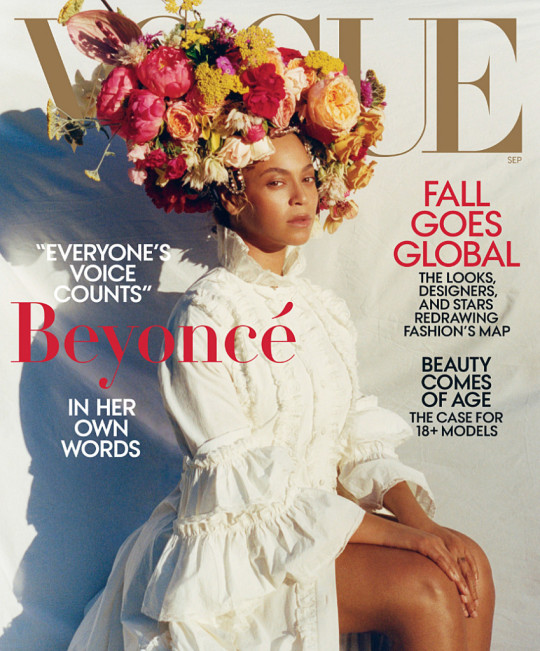
As we begin the read through, these themes are abundantly clear. (my comments are lower cased in parentheses. anything in CAPS or bolded is for emphasis).
Repetitive patterns that emerged in order from the front cover to back cover were:
FALL GOES GLOBAL (main cover line sets the stage for the entire issue. also a possible double entendre warning of falling global markets soon)
“EVERYONE’S VOICE COUNTS” (unless you’re Alex Jones, or someone else that Amazon, Google, Instagram, Twitter, or the Facebook doesn’t like. more on this when Beyoncé has her say later on)
Vogue Forces Of Fashion promotion:
MEET THE TRAILBLAZERS PUSHING THE WORLD FORWARD
198, Letter From The Editor:
“September, for us, always starts in March. That’s when we return home from four weeks of shows and start planning what has traditionally always been our biggest issue of the year. Yet the fall 2018 season didn’t feel like it was business as usual, just as life these days doesn’t feel that way either. In all my time editing Vogue, this period is like no other I’ve experienced before, and for good reason: If fashion is radically different, it is because our world is so radically different. As we sat in meetings after the shows, we spent most of our time talking about how what we wear needs to reflect the times it’s being created for. We barely discussed trends -- in fact, trend is now pretty much verboten in the office because it seems such an outdated way to calibrate fashion. Thanks in part to digital technology and social media, we share a growing sense of global citizenship and kinship, not to mention how so many of us are increasingly looking far and wide for labels to better enhance our sense of personal style. Sally Singer, our Creative Digital Director, coined a phrase for it -- “fashion without borders” -- and it is the perfect representation of what this September is all about.
“You’ll find, then, a celebration of the designers who prefer to dispense with the notion of boundaries all together.
“As I read the story that accompanies the portrait of Virgil Abloh, the young Rockford, Illinois-born creative director behind the label Off-White who just made a terrific start with his Louis Vuitton menswear this past June, something Virgil said seemed emblematic of what we wanted to do. ‘It’s like I’m walking down different streets all at the same time, seeing, smelling, and breathing diversity,’ he said, ‘and realizing that things you grow up with -- race, religion, gender, or anything else -- tend to disappear once you’re embedded in a global community.’
“When it came to thinking about who should be on the cover of this September issue, there was really only ever one choice: Beyoncé. It’s not just because her fame redefines what it means to have a global presence; it’s the way she uses that status to challenge herself -- and us, too.
“More important, Beyoncé is intent on challenging the status quo, drawing out attention to society’s imbalances and injustices -- something that many of our current politicians seem intent on maintaining (or, worse, taking us backward).” (again, keep that word “forward” in mind)
Vogue Insiders.com promotion:
A POINT OF VIEW IS MEANT TO BE SHARED. JOIN AND SOUND OFF
Vogue.com promotion:
SHOP THE WORLD
“From museum-worthy boutiques in Tokyo and Milan to rare beauty finds tracked down from halfway around the globe and delivered right to your door, our style is now truly -- and effortlessly -- international.” (“effortlessly” is the tip-off that we’re experiencing a positive mood extreme)
Maybelline ad:
GLOBAL ROMANCE
Cover Girl ad:
I AM WHAT I MAKE UP (ironic given the current “fake news” environment)
254 Taking Flight:
On Vogue.com ==> “The Wing gears up to go GLOBAL” (women-only co-working club with $2350-2700 a year membership fees)
322 Off The Map:
“E-commerce site Ssense is championing the idea that fashion can come from absolutely anywhere.”
“For Ssense, GLOBALISM ISN’T JUST POSITIVE, IT’S PROGRESSIVE.”
334 BAND TOGETHER
356 Star Spangled:
“While knitwear label Alanui is based in Milan, its foray this fall into dressing us head-to-toe embraces a glittery, glam-rock Americana.” (everyone seems to be focusing globally this year)
380 L’Oréal promotion:
BEAUTY BEYOND BORDERS
“Pinging around the globe at the speed of Instagram.”
499 NEW HORIZONS:
“This odyssey is all thanks to the GLOBALLY MINDED designers who simply refuse to see borders.”
500 ALL AROUND THE WORLD
501 HERE, THERE, EVERYWHERE:
“Fashion has never been more celebratory of GLOBAL DIVERSITY and influence as the best fall looks -- and a visionary group of BOUNDARY DEFYING designers -- ably prove.”
506 FIT TO PRINT
(comment: an ironic nod to the daily, front page, hiding-in-plain-sight, bold-faced admission of censorship by the New York Times: “All the News That’s Fit to Print” -- in other words, what’s “fit” is something only they decide. HIDING IN PLAIN SIGHT ironically appears as a caption on page 585)
519 Demna Gvasalia:
“This stars-and-stripes jacket, which represents the States, is my favorite -- because American culture is what I loved when I was growing up.” (another designer with his eyes fixed on distant shores, who now lives in “clean, calm, safely neutral Switzerland” while spray-painting NO BORDERS graffiti on the set of his latest show. the irony is that Switzerland is clean, calm, and safe because it is neutral and has some of the strongest borders in the world)
522 Gosha Ribchinskiy:
“If you’re not thinking GLOBALLY, your thinking is out of date.”
526 Stella McCartney:
“Climate change, of course, knows NO BORDERS.”
Beyoncé In Her Own Words:
“If people in powerful positions continue to hire and cast only people who look like them, sound like them, come from the same neighborhoods they grew up in, they will never have a greater understanding of experiences different from their own. They will hire the same models, curate the same art, cast the same actors over and over again, and we will all lose. The beauty of social media is it’s completely democratic. Everyone has a say. Everyone’s voice counts, and everyone has a chance to paint the world from their own perspective.”
(comment: the most powerful words in the entire magazine. in direct opposition to the Shadow Banners and to Vogue as well for waiting 126 YEARS before an African-American (23-year old Tyler Mitchell) was allowed to shoot its cover, and only when Wintour granted Beyoncé complete control of the cover story and shoot. also notice not one peep of GLOBAL and NO BORDERS talking points in her words)
580 THE GLOBAL TABLE
582 Age Appropriate
“Stories of burnout -- and worse -- are rife in a modeling industry filled with vulnerable mid-teens. So isn’t it time for the fashion world to commit to working with models old enough to vote?”
(another story that is decades too late. but no mention of the European Migrant Rape Crisis against girls (and even boys) as young as twelve. Due to its NO BORDERS policy, Sweden now has the heartbreaking distinction of being labeled the “Rape Capital” of Europe, while victims and their families are labeled racist for speaking out)
586 “Cover Story”
“Is there seduction in concealment? Safety in charade?”
“The incognito chic of the new coverings speaks equally to our desire to conceal -- and that eternal wish to stand out.”
“This predilection to disappear in plain sight is not limited to the catwalks.” Both Rihanna and Beyoncé sported the look during live shows.
(this was probably the only leading-indicator-style, fashion-inspired social mood alert in the issue, and it was all about the trend toward concealment, which is a negative mood characteristic. could also be an unintended consequence of the #MeToo movement as well as the European Migrant Rape Crisis)
=== end of editorial ===
Here is the result when all the noise is stripped away and the thematic messages are linked together in repetition:
FALL GOES GLOBAL, EVERYONE’S VOICE COUNTS, TRAILBLAZERS PUSHING THE WORLD FORWARD. We share a growing sense of global citizenship and kinship, fashion without borders, a celebration of the designers who prefer to dispense with the notion of boundaries all together. Things you grow up with -- race, religion, gender, or anything else -- tend to disappear once you’re embedded in a global community. Fame redefines what it means to have a global presence. A POINT OF VIEW IS MEANT TO BE SHARED. JOIN AND SOUND OFF. SHOP THE WORLD. From museum-worthy boutiques in Tokyo and Milan to rare beauty finds tracked down from halfway around the globe and delivered right to your door, our style is now truly -- and effortlessly -- international. GLOBAL ROMANCE, I AM WHAT I MAKE UP. Taking Flight, Off The Map. Championing the idea that fashion can come from absolutely anywhere. GLOBALISM ISN’T JUST POSITIVE, IT’S PROGRESSIVE, BAND TOGETHER, BEAUTY BEYOND BORDERS. Pinging around the globe at the speed of Instagram. NEW HORIZONS. This odyssey is all thanks to the GLOBALLY MINDED designers who simply refuse to see borders. ALL AROUND THE WORLD, HERE, THERE, EVERYWHERE. Fashion has never been more celebratory of GLOBAL DIVERSITY and influence. A visionary group of BOUNDARY DEFYING designers. FIT TO PRINT. If you’re not thinking GLOBALLY, your thinking is out of date. Climate change, of course, knows NO BORDERS.
Analysis:
Before we jump to the conclusion that this was an intentional messaging strategy, we had better get a few things straight.
First a definition:
Social mood is a shared mental state among humans that arises from social interaction. It is unconscious, unremembered, and endogenously regulated.
~ Socionomic Theory
Therefore, counter-intuitively, what appears as an intentional messaging strategy is likely unconscious.
But the question remains: what does this shared mental state say about current social mood?
We may find the first hint in Anna’s editor’s letter: “If fashion is radically different, it is because our world is so radically different.”
According to the Socionomic Theory of Finance, “humans herd because they evolved to conform to others’ behavior in uncertain situations as a primal survival tactic.”
In my opinion, the Vogue content flagged above is an example of herding as a form of political survival.
“We’re totally integrated here on one floor. It’s total integration and we meet, we discuss, we talk all the time.”
~ Anna Wintour
While caught up in the negative urge to RESIST the current administration, maybe all the ETF meetings, the discussions, and total-integration-all-the-time have resulted in a sort of unconscious groupthink that has allowed Vogue to get swept up in the same positive social mood extreme that has driven the markets to record highs, by unconsciously embracing the same giddy animal spirits fueling Wall Street.
In other words, groupthink may have undermined Vogue’s own message of resistance. GLOBALISM and NO BORDERS are radically extreme aspects of positive social mood.
William H. Whyte Jr. derived the term "groupthink” from George Orwell's Nineteen Eighty-Four, and described it as “rationalized conformity.”
A recent study may have proved its existence. “How social influence can undermine the wisdom of crowd effect,” by Lorenz et al.,¹ found that social interaction among participants produces convergent opinions, less accurate opinions, and higher confidence in those opinions.
“Convergent opinions” may explain the rampant repetition cited above that essentially blurs into a long stream of social mood conformity. “Less accurate opinions” may explain the embrace of GLOBAL/NO BORDERS ideology that was rejected in America and is steadily being rejected throughout Europe, even though the embrace of these ideologies may have resulted from conformity to the same mood underpinning the raging bull market.
Yale psychologist Irving Janis, who pioneered the initial research on the groupthink theory, wrote:
“The main principle of groupthink is this: The more amiability and esprit de corps there is among the members of a policy-making ingroup, the greater the danger that independent critical thinking will be replaced by groupthink, which is likely to result in irrational and dehumanizing actions directed against outgroups.”
Irrational actions directed against outgroups sounds a lot like how Shadow Banning can happen without realizing it is censorship.
Irrational actions directed against outgroups might explain how Search Engine Manipulation happens -- why, when you type in the word “idiot” into Bing, DuckDuckGo, Yahoo, and Google respectively, this is what you get:




Irrational actions directed against outgroups might explain the embrace of NO BORDERS even as Europe is overrun by its Migrant Rape Crisis and No-Go Zones to the point that far-right voters are surging from Norway to Greece and most everywhere in between.
Irrational actions directed against outgroups might also explain how throughout history the word “forward” gets used as a rallying cry for progress even when ideologies linked to it result in regress. Case in point: Venezuela.
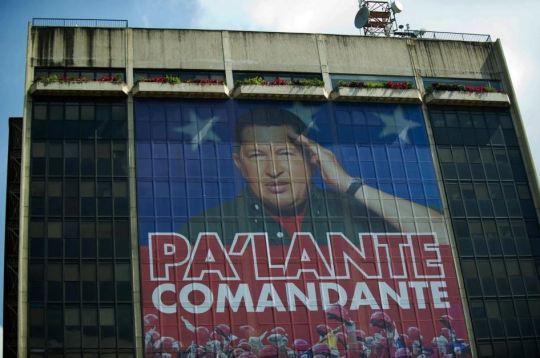
In Latin American slang, Pa’lante is a contraction of "para adelante" or "forward."
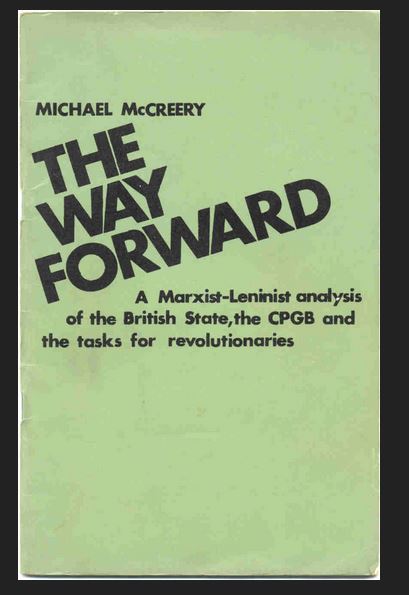

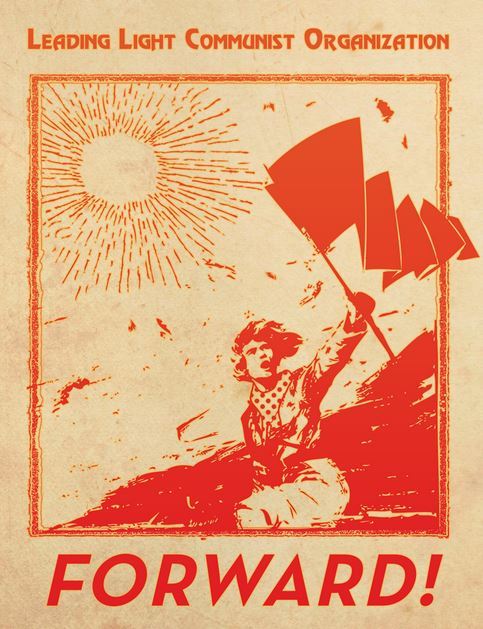
“At Vogue, we’re not much given to looking backward, reasoning that life only goes in one direction -- forward -- and therefore, so should we.”
~ Anna Wintour’s 2017 Editor’s Letter
Zuckerberg’s latest project:

Complete with “Sunset Of Liberty.” (now pulled from site. had to use the Wayback Machine for it from August 30, 2018.)
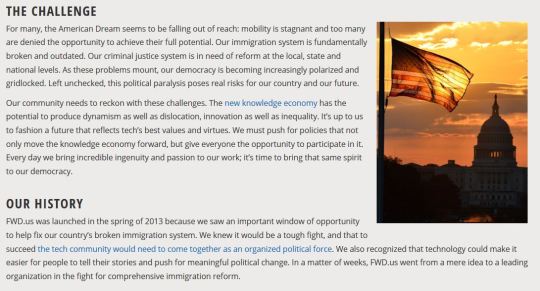
“Forward” to more voters:

“Demonizing immigrants weakens our country. Fighting against hate crimes makes us grow stronger together.”
~ George Soros

In summary, GLOBALISM and NO BORDERS are positive mood manifestations. Constant, effortless travel and a miche mache of global styles reflect an expansionist mood peak at odds with growing angst against income equality resulting from extreme monetary policy.
The irony is that income equality is often blamed on capitalism when a central bank and a progressive income tax are two of the ten planks of the Communist Manifesto.
And here’s what all that miche mache global style looks like: not very coherent, like a bunch of “convergent opinions.” Anna even referred to it as the “creativity of chaos . . . everything all sort of jumbled up and looking like it came from different countries and different identities.”
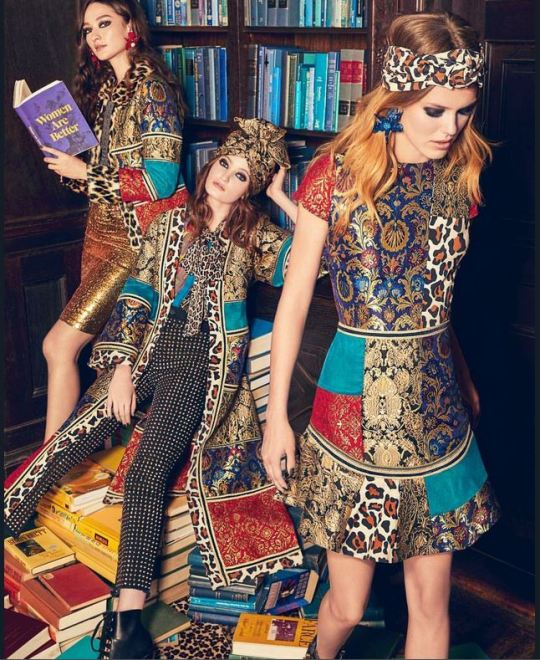
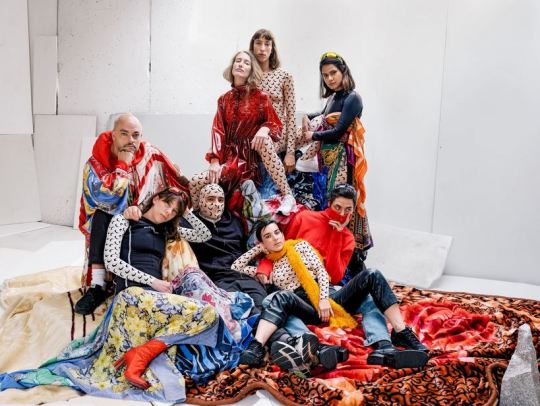
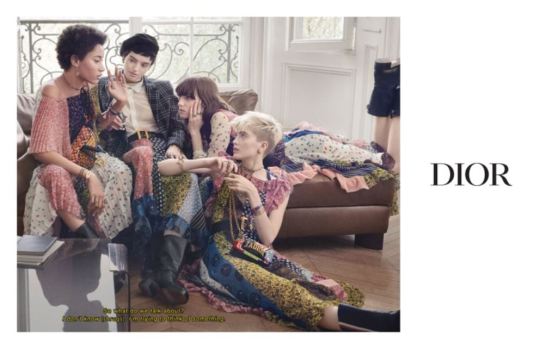
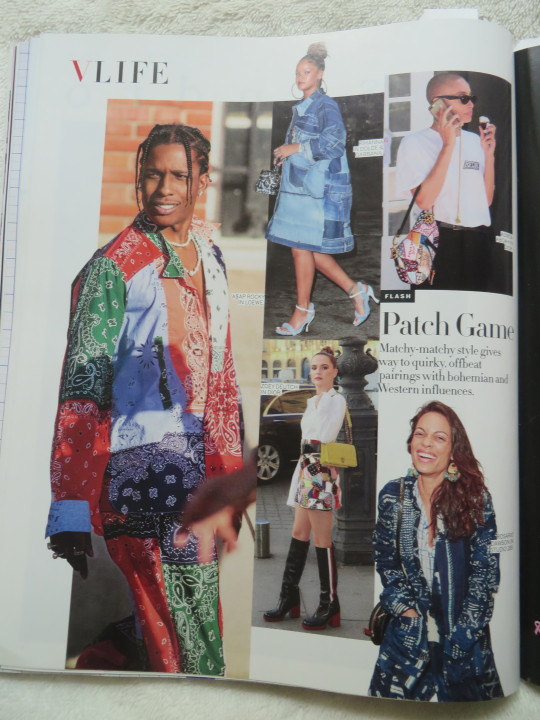
GLOBAL/NO BORDERS, effortless travel, pinging around the world at the speed of Instagram . . . this is what maximum mood expansion sounds like.
Incidentally there is so much demand for air travel lately that JetBlue and United have just raised checked bag fees, again.
And this is what maximum mood expansion looks like:
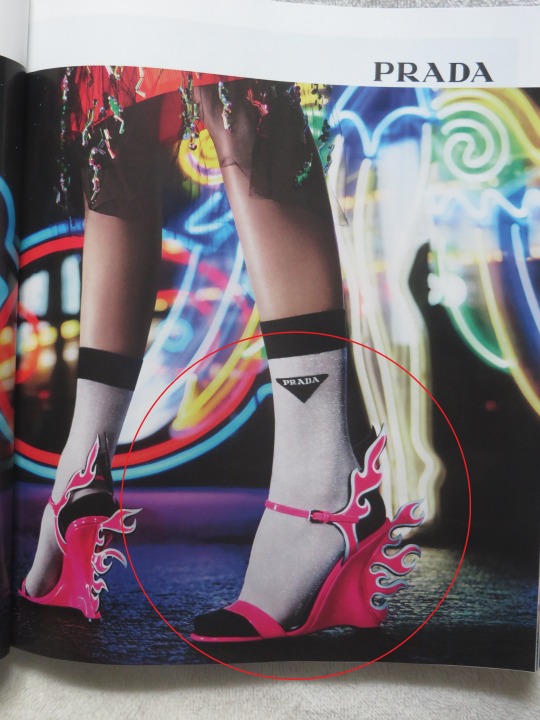
Here are some other examples:
S&P 500 revenues at record highs.
S&P 500 earnings at record highs.
S&P 500 profit margin at record highs.
GDP revised up to 4.2%.
US consumer confidence at 18-year highs.
Highest job satisfaction reading since 2005.
Lowest unemployment rate in almost 50 years.
Recent headlines:
Luxury Lounge Wars Heat Up as Airlines Vie for High-end Passengers
Luxury Housing is Hot, Hot, Hot
Personal Loans Surge to a Record High
A record 95% of American manufacturers recently declared themselves optimistic about the economy
The Art Fair where $20 million Impulse Buys are the New Normal
At $9.7 Million a Pop, Private Jets are Luring Buyers Again
Home Price Insanity: $2.6 Million for 900 Square Feet
But probably my favorite dead-simple, long-term forecasting tool is the S&P/Case-Shiller 10-City Composite Home Price Index. This has me looking for another bump in the road before a run to final highs in possibly 2021-2022 which should coincide with further highs in stocks.

Thus, the march “forward” will likely be slow until we reach a depression when it will once again be a rallying cry for the “economically oppressed.”
Sadly, then capitalism will likely get the blame for our day of reckoning even though it was central banking (central planning) that created the imbalances that needed to be corrected.
The negative mood forces that ushered in Trump’s victory have given way to euphoria, but angst is still smoldering here and abroad as evidenced by Europe’s far-right resurgence with anti-immigration as its core ideal. Since we are all now riding the same liquidity wave, we should pay close attention to other markets as well.
Therefore, the observations made in last year’s September Vogue Mood Report still stand: authoritarianism may still be on its way as countries “crack down” on loose borders.
Socialism in America will probably have to wait until after the excesses have been purged from the system and the jackboots fill the streets. Then, “forward” might seem like the only way for many.
Vogue is warning us of a potentially significant mood peak and thus the potential for a significant market peak. But it is still possible that higher highs can be made based on pure momentum, even after another period of adjustment.
Positive social mood can also feed on momentum, so expect higher until it flames out. You can always check with Mood Report for market timing.
On the other side, social mood is sky-high even as negative aspects of it continue to build beneath the wave.
This is most likely because of the degree of the potential peak at hand. Like a cresting tidal wave, the crest itself may take a long time to form, but meanwhile below the surface the energy is building for the wave to roll over and crush the unexpecting. Likewise with social mood. As with the interplay of yin and yang, excesses in one yield excesses in the other as the opposing forces remain in flux at all times.
I have tried to avoid making this report a political diatribe, but instead have attempted to show that we are at the whims of social mood. The best we can do is identify it and try to either accept it or align with it as best we can. Social mood dictates the mode of events, not the events themselves. We can only control our reactions.
Thanks for reading.
References
¹ Lorenz, J., Rauhut, F. Schweitzer and D. Helbing, “How Social Influence Can Undermine the Wisdom of Crowd Effect,” Proceedings of the National Academy of Sciences, 2011.
1 note
·
View note
Text
Nights of Azure

Nights of Azure is a recent hack and slash action game from the makers of the Atelier series, Gust Co. Ltd, and published by Koei Tecmo. It was released back in October of 2015 for the Playstation 3, 4, Vita, and Windows; it was released a year later in March for America and in April for Europe. When I saw the game I knew nothing about it; it was always sitting on the shelves in the store. I was interested but skeptical; I’ve played games from Koei, but never fully played through a Gust game. I knew that this had nothing to do with the Atelier series, I believe it is its own stand alone series. After a while I picked up the game to finally see what was staring me in the face for quite some time; so what impression did Nights of Azure leave me? Well it’s rough, but it has potential; the game has it’s pros, like a pretty good story or likable characters. However, the game also has it’s cons; gameplay can be good but bugs and other issues hurt it, and the visuals need some work in areas. It’s not the best game I’ve played, but it’s far from the worst. Lets start at the story and work our way through.
Nights of Azure follows the story of two girls in a world filled with demons; long ago a war was waged and it ended with the demise of the demon king. Upon his defeat his blue blood was spilled upon the world; due to this humans, animals, and even every day objects began to turn into demons. Fast forward and we find the demon hunter Arnice as she arrives on a island effected by the blue blood. She is tasked with escorting the next saint so that she may keep the demon king from reviving; however, when Arnice finds out who the next saint is her spirit wavers. Lilysse, a fragile priestess and a close friend (or maybe more *wink wink*) to Arnice, has been chosen as the next saint. Will Arnices feelings for Lilysse get in the way of her task, or will she follow through regardless of the time they both shared? Is there a way to do both?
I really like Nights of Azure’s story, it’s really well done in how it weighs both options. The game has Lilysse with you almost all the time, so you get a lot of moments to learn about her and her character. Not everyone will like her of course but it’s understandable why Arnice wishes to keep her from her task. However, this is to save mankind, should one girls life mean the death of earth itself? Though, of course, there is stuff hidden behind the scenes; the group giving Arnice and Lilysse their jobs are kind of shady in how they handle things. It makes you question if this who saint business is really working. Though the story is nothing new; many games and other media have done this before. The recent game, I Am Setsuna, from Square Enix is one that comes to mind. Plus given that another game is in the works some of the story is left unresolved, or isn’t explained to well. There were a lot of moments near the end that I couldn’t follow; namely the endings of the game. There is more than one ending to the game, but how to get them and what is actually happening are unknown to me. It doesn’t feel like I fulfilled one of the specific goals either; when the game ends it just feels like I finished a normal mission and am on my way back to the hub. The story has it’s moments; it’s not a bad story, but it could still use some work. As for the characters, I think this is the games strongest part.
Nights of Azure has a small yet interesting set of characters; you have our main two Arnice and Lilysse, but then comes the supporting cast. A butler that wishes to protect the girls, but knows that the mission comes first; a merchant who is obsessed with getting filthy rich. A researcher who wishes to know more about the monsters, and a demon who goes against her kin. The characters are really likable and interesting even through the ups and downs of the game; I’d say this is due to the voice work more than anything. It’s clear that the actors were getting into their roles and really trying to sell what they had to offer. However, there are some character story elements that are never explained. You get some nice insight on Arnice and Lilysse’s past, but the supporting cast sometimes never reaches any closure. For the merchant and the researcher one of them was sent by the Curia, the group giving orders to Arnice, while the other is an impostor. This, as far as I remember, was never resolved; neither of them seemed like they meant anyone harm and in the end both should sincere worry towards the two girls. As for the demon, her story doesn’t come to a conclusion unless you choose to do an optional boss. She’s a really interesting character, but you need to beat the final boss once to unlock the fight; yet even then you don’t need to fight the boss, just go back to the final boss and you’re done. Arnice and Lilysse are really the only two that get much development in every direction; even the demon king and his story are poorly developed. You only really get the story of his defeat and that’s it. The characters could be better, but regardless of completed story or not; the characters are still interesting to say the least. Now while the characters might be one of the games better moments, the visuals are not.
Nights of Azure is, by far, not a triple A title. It’s clear that the budget for the game is small in comparison to other titles. That being said, the visuals aren’t all bad; however, it’s clear as day when the visuals take a turn for the worst.
youtube
I couldn’t get a video of just the scene along, but here is a little gameplay and the cutscene I wanted from a lets play of the game. If you wish to only watch the scene I will explain skip to about 26 minutes in; though you can see how the game plays as well as the first boss if you like as well in the video. In the scene following the first boss, Arnice meets with the demon king; the demon king speaks to her and introduces one of the mechanics of the game. Arnice can transform into different forms in battle, but instead of showing her actually transform the developers instead chose to overlay her model with a JPEG of the transformation. It could have been the model itself, but the visual looked so flat and lifeless I thought someone cut and pasted a picture and said screw it. Another problem I have is the needless desire to have sex appeal.

There isn’t to much of this in the game, but when you go to upgrade yourself like the picture above it’s unavoidable. The developers shrug it off by saying this is needed; that Arnice must wear almost nothing at all here for the ceremony to work. Why, I understand sexuality is far different in Japan than America, but at least give a better reason. That aside, I really like the design of the scenery as well as the Arnice and her many forms. The picture above is a great example of scenery; The huge unknown structure looming in the back in such a peaceful shrine, accompanied by relaxing music as well (we’ll get to that soon), or the dark and dreary neighborhoods of the island kingdom we’ve been placed in. The scenery of the game, while not always one hundred percent perfect is in my opinion the best of the visuals. As for Arnice’s other designs.

You’ll see a decent amount of Arnice and her transformations through the game; at the end of the game you’ll get a collection of concept art and other extras as well. The transformation above is the last you’ll receive and it’s my favorite in terms of design. The color scheme, the wings, the crown, etc. To me, this whole design is eye catching to me; though this is only one of five transformations Arnice goes through, each with their own unique play style and design. As for the music of Nights of Azure, it’s got some memorable tracks; however, it’s still somewhat forgettable. Though memorable or not, the soundtrack is really good. I went back and listened to a few songs to find what I wanted for the review and it holds up. Here are a few that really stuck with me.
youtube
youtube
youtube
youtube
Overall the visuals aren’t terrible in terms of the games budget, but there are still times even I feel improvement could have been done. The soundtrack is good, but there aren’t a lot of memorable songs in my opinion. Lastly we have the crux of the game, it’s gameplay.
Like I said before, Nights of Azure is a hack and slash action game. Throughout the game you will take Arnice around the island taking one demons to achieve your goal. You attack with your sword, or when you get further other weapons as well; though Arnice is special. Not only can she transform in battle as I said before, but she can also recruit and command demons called servan. Each servan has something special about them; one could be pure brute strength while another could be a healer. Arnice is only able to have four on a team at once so choose wisely before heading out. Gameplay is pretty simple, if you’ve played a hack and slash before you should do fine; the biggest problem however is that the gameplay will start to get a little stale. I platinumed Nights of Azure; it’s an easy yet overly time consuming endeavor. Though if you’re like me and want to complete the game, you’ll find that without the story or characters to keep you moving the game will start to get going. I didn’t care when I was in the story, but post game when I was wrapping everything up it got really repetitive. Not to mention the game isn’t free of bugs either; they’re nothing to drastic like a complete crash of the game, but the frame rate may drop depending on what is happening currently on the screen. The game is fun while it lasts but once it’s over, it’s hard to stay invested.
Overall i give Nights of Azure a 6 out of 10, it’s above average, I liked what I played but it was clear that the game needed work. It’s not perfect, but the game can be more. I hope with the second title this series can become something good for Gust. It just needs more story in areas, more supporting character development along side the main characters, Visuals that fit the budget all the way through and some more lively gameplay. If they take the first game and add to it as in the second game I think that can be achieved. I recommend trying the game at least once; it’s not for everyone, but you never know if you might find it enjoyable. If you find the game at full price don’t buy it, get it on sale or at a lower price.
Happy Valentines day everyone, it’s a little later in the day, but I’m happy I could get the review out when I said I would. Next week on friday will be the review for Love at Fourteen. Until then however, have a nice day be you on your own or with the one you love.
#Nights of Azure#koei tecmo#gust co ltd#gaming#video game#video games#sony#playstation#playstation 3#PlayStation 4#PlayStation Vita#ps3#ps4#psvita#microsoft#windows#Microsoft Windows
0 notes
Text
Bloodroots Review — Hackin’, Whackin’, and Smackin’
March 3, 2020 2:30 PM EST
Bloodroots is a highly-replayable romp that will see you utilizing everything from a fish to a carrot in order to take down foes.
Games like Hotline Miami, Katana Zero, and Superhot have been some of my favorite indies over the past few years due to each title’s fast-paced nature and reliance on one-hit-kills. If you have a game of this ilk that is entirely focused on snappy gameplay and getting as high of a score as possible, there’s a good chance that I’m going to be a big fan.
Bloodroots from Paper Cult is the latest game to be cut from this same cloth and wouldn’t you know, I love it a whole bunch. With tight gameplay mechanics, well-designed levels, and an art style that brings the whole package together, Bloodroots is one of the more enjoyable indies that I have played in recent memory. It had me encouraging myself to make just one more run more times than you can imagine.
youtube
“Bloodroots is one of the more enjoyable indies that I have played in recent memory.”
Bloodroots places you in the shoes of a wolf-hat wearing character that simply goes by the name Mister Wolf. This one-eyed, bearded fellow is thought to be killed by a posse known as The Blood Beasts during the opening moments of the game. After recovering, Mister Wolf sets out for revenge against The Blood Beasts and its leader, Mister Black Wolf, killing anything and anyone that might be in his path in the process.
Largely, the story takes a backseat to the action throughout Bloodroots, but the writing and throughline narrative within the game is enjoyable. All of the major characters in the story, especially each member of The Blood Beasts, are enjoyable and well-written in their own way. Mister Wolf himself isn’t a cult of personality by any means, but he’s also a more-than-adequate protagonist that is focused on getting revenge and nothing else.
The basic story set up in Bloodroots is mainly meant to serve the main allure of the game, which is the gameplay. As briefly mentioned, Bloodroots plays somewhat similarly to a hack-and-slash version of Hotline Miami where one single hit can take down not only (nearly) every enemy that you’ll come across, but also your own character. However, the biggest difference in Bloodroots compared to similar games is virtually everything you see in the environment can be used as a weapon. This includes standard weapons you might find like an ax, a sword, or a wooden plank, but also encompasses some off-the-wall items like a carrot, a fish, or shish kebabs. Anything and everything in Bloodroots is a weapon, which can lead to some hilarious takedowns, especially during the game’s cinematic kills which activate when murdering the final person in each section of any given level.
Bloodroots’ gameplay is very simple at a baseline level, but the depth the game offers makes it so much more enticing. While each weapon you utilize usually has three hits until they break, Bloodroots actively encourages you to vary your weapon choice as much as possible. One of the scoring modifiers in the game stems from how often you change up the weapons you’re using. So, if you opt to just use certain items too often in a level, you won’t have as high of a final score.
The more you play Bloodroots, the more your goals start to become multi-layered. Not only are you trying to kill every enemy in each level, but you’re also trying to do so as fast as possible while also making sure that you’re utilizing different weapons and keeping your killstreak combo intact. It’s hard enough to get through some levels in Bloodroots on their own, but it becomes an entirely different feat when you’re trying to blaze through levels while constantly switching weapons to vary your takedowns and pursue a higher score. There’s really a ton of depth here and makes the game extremely replayable, especially if you’re aiming to get a high score on the leaderboard.
For the most part, the level design in Bloodroots is pretty great and frequently mixes things up enough that it never feels stale during its brief runtime. The placement of enemies in each level is also typically really smart and often times feeds you down a specific route that ensures the fastest path to completion. It’s during these moments where you utilize the items laid before you to take down foes in a certain pattern that you feel extremely powerful.
That said, the level design is also what I found to be one of the biggest weaknesses in Bloodroots, too. Some levels in the game feature platforming sections, which to me, almost never felt satisfying in Bloodroots. This stems mostly from the fact that I found it really hard to discern depth at times. While Mister Wolf has a slightly visible shadow underneath his character model, too often I was jumping right off the edge of a stage because I couldn’t tell how close or far I may have been to the next platform. Any time I had to do some platforming for any period of time, I wasn’t too pleased.
There are also some sections in certain levels that drastically change up the gameplay for a few brief moments for seemingly no reason. More often than not, I never cared for these areas and found that they just stifled any momentum that a given level may have had. One section of Bloodroots, in particular, mirrored the gameplay stylings of Flappy Bird which I found to be a pretty major drag.
I’ve mentioned it already, but one of the best parts of Bloodroots comes with how much longevity there is to the game. While completing one single playthrough will only take you a couple of hours, there are countless collectibles to find, high scores to chase, and gameplay stylings to master. Each level also can be replayed while wearing a different hat on Mister Wolf. Each hat gives you different abilities and can change how you might approach a level, as well as alter certain gameplay aspects. If you get obsessed with trying to reach the top of the leaderboards as I have done, then you’ll likely find yourself coming back to Bloodroots time and time again.
“Bloodroots is a very simple, straightforward game at face value, but it’s also one that offers tons of replayability and features a high skill ceiling.”
I also can’t go without mentioning the art style of Bloodroots, which is pretty much a visual joy at all times. There have been a lot of comparisons between the art styles of both Bloodroots and Samurai Jack; those comparisons are pretty spot-on. The expressiveness of the characters combined with the colorful locations you’ll see in Bloodroots always made the game visually appealing, even during some of the aforementioned levels that I wasn’t the biggest fan of.
On the performance front, Bloodroots definitely isn’t without a few issues here and there. I played the game primarily on a PS4 Pro where I was met with some surprisingly long load times prior to each level. I also experienced instances of the frame rate dropping. These dips in the frame rate didn’t occur nonstop and primarily happened when there were numerous enemies on the screen at a single time. For the most part, neither of these minor issues ruined my experience at all, but I figured it was worth mentioning.
Bloodroots is a very simple, straightforward game at face value, but it’s also one that offers tons of replayability and features a high skill ceiling. If you’re a fan of games that are all about mastering gameplay mechanics in pursuit of that one, perfect run, you really can’t do better so far in 2020 than Bloodroots. It’s a game that I’m very much looking forward to returning to time and time again over the coming months.
March 3, 2020 2:30 PM EST
from EnterGamingXP https://entergamingxp.com/2020/03/bloodroots-review-hackin-whackin-and-smackin/?utm_source=rss&utm_medium=rss&utm_campaign=bloodroots-review-hackin-whackin-and-smackin
0 notes
Text
How Pokemon Cards Are MadeHow Pokemon Cards Are Madevideo games
New Post has been published on https://www.gamerzcourt.com/how-pokemon-cards-are-madehow-pokemon-cards-are-madevideo-games/
How Pokemon Cards Are MadeHow Pokemon Cards Are Madevideo games
Creatures, Inc. is an often-overlooked arm of the Pokemon machine. The developer has worked on spin-off Pokemon games for years, starting with Pokemon Stadium in 1998 and most recently Detective Pikachu–as well as 3D Pokemon models for various games, including Super Smash Bros. But the company is also responsible for much of the Pokemon Trading Card Game, which consistently sees new series and expansions after over 20 years.
We recently had a chance to tour Creatures Inc.’s Tokyo, Japan office to learn about the process of creating Pokemon cards. During our tour, we spoke to Atsushi Nagashima, game director for the TCG, and Mitsuhiro Arita, a longtime freelance illustrator responsible for over 500 Pokemon cards–including the infamous holographic Charizard card–about how cards are conceived and then illustrated. We also talked to Satoru Inoue, the test room lead at Creatures, about how cards are playtested and how balance problems and broken cards are addressed by the team.
There are three main parts to making a new Pokemon card: coming up with the idea for the card, commissioning art, and testing the card with the current TCG rules. This involves a team of game designers, over 70 artists, and 19 playtesters working full time to create and execute new card series and expansions.
Step One: Pick A Pokemon
According to Nagashima, the most important thing when coming up with a new set of cards is variety. There needs to be a mix of art styles and types of cards; some need to have strong competitive potential, while others need to be appealing to collectors. But the first step to creating a new set is deciding which Pokemon to use.
“Near the beginning of a new series [based on the latest video games], we really try to take care to stay true to the video games that we’re basing the card series on–for example, the Pokemon that were featured heavily in that video game or had a big role in the story, we’ll make sure they’re kind of at the center of the set we’re making,” Nagashima said. “But once we’re kind of mid-way through the series, we start focusing more on play environment overall…and decide which Pokemon to put in based on that.”
A lot of those choices come down to what the game needs to feel more balanced and what Pokemon suit those needs, Nagashima said. But the team also considers which Pokemon don’t get a lot of love in the games or anime, the ones kids might find cool, or even Pokemon they themselves like.
“One of my favorites is Darkrai, and I think you’ll notice that there’s a lot of strong Darkrai cards,” he said, laughing.
Nagashima at the Creatures office.
There are also background stories and themes for each expansion, though that’s not really communicated to players. “In the [XY Breakthrough expansion], the theme we had for that was two parallel worlds. They both featured Mewtwo, so there was a Mewtwo that was in this advanced world…and there was a Mewtwo that was more old-fashioned,” Nagashima explained. “These two parallel worlds collide and then the world goes into chaos and is destroyed as a result of that.”
According to Nagashima, one of the team’s biggest challenges is maintaining the spirit of certain characters and Pokemon while putting their own spin on things. Because the card game is closely tied to the video game, it can also be tricky to translate certain game mechanics into ones that work in the TCG–like Mega Evolution, for example.
“In the trading card game, you have your basic [Pokemon]. You evolve it to Stage 1 and [then Stage 2], so there are two steps to get to your final evolution in general. If we added another step on top of that, you just wouldn’t have enough room in your 60-card deck to really make that feasible,” Nagashima said. “So we took the approach of only having Mega Evolutions for cards that were already really strong–so there was already an EX card and then that would evolve to the Mega-EX. We tried to reduce the number of steps in that way.”
Ultimately, Nagashima says, the TCG team is always trying to keep things fresh and varied while still paying attention to the competitive meta, and it’s a complex balancing act even from the beginning.
Step Two: Illustrations
Once the team has decided on the kind of card they need and who (or what) will be on it, it’s time to get the art process started. Creatures currently works with 73 different illustrators and artists to ensure sets are varied. One of the most prolific of them is Mitsuhiro Arita, who’s been working on the TCG since the beginning and has illustrated 537 cards to date.
Above: Arita at the Creatures office. Slideshow: Mewtwo-GX, Giovanni’s Scheme, and the Lurantis card, all mentioned below.
Arita showed us his workspace at the Creatures office, part of a pod of desks set up for freelance artists to work on confidential designs. Each desk is configured based on the artists’ home offices, usually with tablets for digital art and coloring. He walked us through his illustration process for a recent Lurantis card, paying special attention to dynamic shading and bright background colors to capture the spirit of the Pokemon.
Creatures sends the artists details about the card: what the Pokemon is, the kinds of moves it will have, and any important background information, especially when the Pokemon in question is in a game that hasn’t come out yet. This also applies to Trainer cards, and even the vaguest instructions influence the art; for example, Arita received instructions for a Giovanni card with an “imposing” feel, so he gave it a more classical painting style rather than a cartoony one. For holographic cards, Arita will usually specify which parts of his art should shimmer, though the final holo design is a collaboration with Creatures staff.
In the Red and Green days, Arita and the other artists only had the in-game sprites and limited official artwork to work off of when creating cards. Still, he’s responsible for some of the most iconic cards from the original series, including holographic Charizard and the original fat Pikachu. In a binder filled with all his designs so far, the first few pages could have been any Pokemon-obsessed kid’s collection in the late ’90s.
“Specifically this Charizard and that Pikachu are some of the most memorable cards for I think a lot of people who played the game originally, and I always thought that I’d probably never be able to draw cards that people would like better than those two,” Arita said. But a Mewtwo-GX card he recently designed is his new favorite, and he says he’s been getting good feedback on it.
Unexpectedly, the same artist is unlikely to work on every Pokemon in an evolutionary line. In the original card series, Arita illustrated Bulbasaur and Venusaur but not Ivysaur (which was done by Pokemon artist Ken Sugimori). While there are some cases where a consistent style is called for across an evolutionary line–like these adorable Tepig family cards–they’re usually usually split up between artists, presumably for variety or time efficiency.
Efficiency especially is key, since many of the cards go into the testing phase even before the art is finished.
Step Three: Full-Time Playtesting
At Creatures, there’s a special room dedicated to testing the card game. It’s in the back of the small office, and it’s filled only with tables, chairs, and drawers upon drawers filled with years of Pokemon cards. Seven hours a day, five days a week, 19 playtesters play the TCG to see how new cards fare. (The odd number doesn’t seem to be a problem, apparently.)
Because they’re mostly testing cards that haven’t been released yet, the playtesters have to work with what they have. Work-in-progress cards are actually stickers put on old cards so they can still be played in normal decks; if the illustrations aren’t finalized, these stickers will use generic art of the Pokemon (or whatever the card subject is) with the complete moves, name of the card, and suggested effects, HP, and damage.
According to test room lead Satoru Inoue, those smaller adjustments happen “extremely often,” while they’ll usually see at most two or three drastic revisions before cards are finalized. Nagashima noted that competitive players will sometimes use released cards in completely unexpected ways, in which case the card has to be banned–he specifically called out Lysandre’s Trump Card, which was banned in 2015 for making games severely imbalanced.
Even with all the playtesting, competitive players regularly surprise the team. Nagashima cited Shintaro Ito’s Mega Audino deck, which won him the 2016 Pokemon World Championships in the Masters Division, as a recent example–he didn’t expect the card to be nearly as viable as it was.
Inoue, Nagashima, and Arita in the Creatures lobby.
Nagashima’s favorite strategy, though, is one he himself was heavily involved in designing: the infamous Night March deck, which dominated much of the competitive scene in 2016 and won the US Nationals that year.
“I was only making it with the assumption that it would maybe make it to the finals, but not take the entire thing!”
Walking back through the office at the end of the tour, nearly every desk is filled with Pokemon toys and merch. It’s very clear: From the design and art to the test room, the most important thing for Creatures’ TCG team is loving Pokemon.
GameSpot News
0 notes
Text
Game Review: Gravity Rush 2 (PS4)
The original Gravity Rush started its life as a PlayStation Vita title to a fairly warm reception. It wasn’t until the PS4 remaster, however; that I really sunk much time into it. Its awkward movement controls seemed far easier with a controller than tilting and turning a portable gaming system around in one’s hands. Its sequel, the plainly titled Gravity Rush 2, sadly does nothing to fix the problems of the original and gives us more of the same in ways that are good and in many ways that are, unfortunately, very bad.
Being a typical sequel that tends to go bigger than its predecessor, Gravity Rush 2 does a few things right; it gives us a bigger and more colorful world than the bland Hekseville and its surrounding areas from the prior game, and it introduces us to new gravity powers for our heroine, Kat, giving us something fresh and new to this Playstation 4 exclusive. While the new location Jirga Para Lhao is bright and colorful, it is also packed full of far more detail than any location in the previous outing and looks absolutely gorgeous.
Gravity Rush 2 takes place following the conclusion of the last game and also follows events that take place after the 2 part Gravity Rush animated web series. The story here is all over the place and feels more like several short stories trying to share some tiny narrative thread to keep them all connected. Various side quests do contain some fun stories, but due to an instant fail system attached to many of the tasks you attempt, they become far more tedious than they should be. After the first wave of credits roll, there is a side mission that furthers the story here, including one painfully slow chapter that has you roaming the halls of an empty castle and another that feels more like some sort of puzzle game.
Previous characters from Gravity Rush: Remastered make appearances here, some major and some minor. These encounters are used to great effect and further show off the wonderful characters this series has. Syd and Raven are both here in large rolls, and the new characters Cecie and Lisa are just as entertaining. The story also digs into who Kat is and how she came about arriving in Hekseville at the start of the first game. Gravity Rush 2 allows us to play as Raven, and its first wave of story DLC this March will further this as it seems centered around her, and that’s a good thing.
Kat unlocks two new powers at different points in the story. First up is the Lunar style which makes Kat extremely light and able to do some fun dash attacks. She can also Superman jump, however; it only seemed to really be useful when certain challenges would disable your gravity powers. The Jupiter style works to the opposite and makes Kat control very slow and heavy. Her attacks require some time to pull off but should you be lucky enough to fully charge the attack, then it will have a very devastating outcome. Aside from a few moments in the game, I found that the regular powers Kat had to be far more effective and reliable, and that is mainly due to the poor controls and a lack of a true targeting system for combat.
Despite the jump to new hardware and no reliance on a Vita version to hold it back, the controls haven’t been fixed or made easier here. You can still use the analog sticks or the motion control built into the PlayStation 4 controller, and your reliance on either will depend on how comfortable you are with the gravity falling. There is still no targeting system and the loose targeting the game has is rather poor and simply can’t be relied upon during intense moments. My opinion on the gravity flying controls haven’t changed since the prior game, so feel free to check out my review for that here. Kat still is awkward to control as you never truly feel like you have much control of her, especially during gravity slides. When you see Raven flying around she looks calm, and in charge, a feeling you never have as Kat, or even during the brief moments playing as Raven herself. There is still an insane amount of over correction needed should you nearly miss a target or accidentally cling to the side of some object when you are merely trying to race by it. Gravity Rush 2 still controls so painfully poor that I’m surprised that no effort was made to make it easier to do so. Sequels should improve upon the prior game and Gravity Rush 2 in some ways makes things a lot worse.
The new locations in Jirga Para Lhao are packed with detail and feels far more alive than any area showed so far. These new areas also give us tons to throw as Kat has the ability to grab multiple objects to whip and toss at various enemies. I relied greatly on this power as it has a lock-on mechanic that works far better than the loose lock-on you have during your ‘flying’ moments. Large scale fights in some of the city streets can be a bit too much for the camera and can make combat a chore. Streets are filled with people that can be used during side missions to talk with, hand flyers out to or just take pictures of with the game’s camera item. There are floating chunks of city all around you, with the richer folk living higher up and the poor living far far below. This rich and poor dynamic fits into parts of the main story and many of the side quests as well.
There are also timed events and move based challenges here that should you be comfortable and capable of moving Kat around, can offer a nice distraction from the main story and side quests offered. I couldn’t complete a few of them due to the sheer complication of moving Kat around and had my PS4 not deleted my save file, I would have come back to them and wrapped them all up. This bodes true of a few side quests I had planned on completing, but that sadly won’t happen now. Thankfully, before my save was deleted, I was able to complete the main story campaign.
Visually, Gravity Rush 2 is fantastic and its art direction, much like the last game, is to be applauded. The characters and environments are stunning and wonderfully designed. The visual differences between the PS4 version and the PS4 Pro aren’t drastic, but the game does look slightly better on the PS4 Pro due to its use of geometry up-scaling. This allows the PS4 Pro to display a ‘pseudo-4k’ image where edges appear to operate at a native 4K while pixel shader operations continue to display a standard 1080p image. It’s a bit of a trade off since while edges of buildings and objects are crisp and sharp, the textures and shading contained within are displayed at quarter resolution. Each version is locked at 30 frames per second, whereas Gravity Rush: Remastered ran at a fairly smooth 60fps, which could be one of the reasons the prior game controlled better.
The game also features the return of the comic book style cutscenes and these are great. You can tilt the controller to get some added depth to them, even if doesn’t really make them better. There are numerous cutscenes and many of them are vastly entertaining. The one issue I had with the standard in-game cutscenes is that they revert back to the regular costume for Kat even if you have her wearing something else, despite the cutscenes using the in-game engine.
I was extremely hopeful for Gravity Rush 2, a game I had been looking forward to for quite some time. After being in development for nearly five years, I had hoped that the issues surrounding the previous game would have been addressed or fixed in some way. The game can at times work and function as intended, but sadly those moments are too few. Combat can be hectic and truly frustrating due to the poor camera system and lack of any reliable targeting system. Gravity Rush 2 is fantastic to take in, admire and enjoy, just don’t expect playing it to be much fun.
Game Review: Gravity Rush 2 (PS4) was originally published on Game-Refraction
0 notes
Text
How A Pokemon Card Is MadeHow A Pokemon Card Is Madevideo games
New Post has been published on https://www.gamerzcourt.com/how-a-pokemon-card-is-madehow-a-pokemon-card-is-madevideo-games/
How A Pokemon Card Is MadeHow A Pokemon Card Is Madevideo games
Creatures, Inc. is an often-overlooked arm of the Pokemon machine. The developer has worked on spin-off Pokemon games for years, starting with Pokemon Stadium in 1998 and most recently Detective Pikachu–as well as 3D Pokemon models for various games, including Super Smash Bros. But the company is also responsible for much of the Pokemon Trading Card Game, which consistently sees new series and expansions after over 20 years.
We recently had a chance to tour Creatures Inc.’s Tokyo, Japan office to learn about the process of creating Pokemon cards. During our tour, we spoke to Atsushi Nagashima, game director for the TCG, and Mitsuhiro Arita, a longtime freelance illustrator responsible for over 500 Pokemon cards–including the infamous holographic Charizard card–about how cards are conceived and then illustrated. We also talked to Satoru Inoue, the test room lead at Creatures, about how cards are playtested and how balance problems and broken cards are addressed by the team.
There are three main parts to making a new Pokemon card: coming up with the idea for the card, commissioning art, and testing the card with the current TCG rules. This involves a team of game designers, over 70 artists, and 19 playtesters working full time to create and execute new card series and expansions.
Step One: Pick A Pokemon
According to Nagashima, the most important thing when coming up with a new set of cards is variety. There needs to be a mix of art styles and types of cards; some need to have strong competitive potential, while others need to be appealing to collectors. But the first step to creating a new set is deciding which Pokemon to use.
“Near the beginning of a new series [based on the latest video games], we really try to take care to stay true to the video games that we’re basing the card series on–for example, the Pokemon that were featured heavily in that video game or had a big role in the story, we’ll make sure they’re kind of at the center of the set we’re making,” Nagashima said. “But once we’re kind of mid-way through the series, we start focusing more on play environment overall…and decide which Pokemon to put in based on that.”
A lot of those choices come down to what the game needs to feel more balanced and what Pokemon suit those needs, Nagashima said. But the team also considers which Pokemon don’t get a lot of love in the games or anime, the ones kids might find cool, or even Pokemon they themselves like.
“One of my favorites is Darkrai, and I think you’ll notice that there’s a lot of strong Darkrai cards,” he said, laughing.
Nagashima at the Creatures office.
There are also background stories and themes for each expansion, though that’s not really communicated to players. “In the [XY Breakthrough expansion], the theme we had for that was two parallel worlds. They both featured Mewtwo, so there was a Mewtwo that was in this advanced world…and there was a Mewtwo that was more old-fashioned,” Nagashima explained. “These two parallel worlds collide and then the world goes into chaos and is destroyed as a result of that.”
According to Nagashima, one of the team’s biggest challenges is maintaining the spirit of certain characters and Pokemon while putting their own spin on things. Because the card game is closely tied to the video game, it can also be tricky to translate certain game mechanics into ones that work in the TCG–like Mega Evolution, for example.
“In the trading card game, you have your basic [Pokemon]. You evolve it to Stage 1 and [then Stage 2], so there are two steps to get to your final evolution in general. If we added another step on top of that, you just wouldn’t have enough room in your 60-card deck to really make that feasible,” Nagashima said. “So we took the approach of only having Mega Evolutions for cards that were already really strong–so there was already an EX card and then that would evolve to the Mega-EX. We tried to reduce the number of steps in that way.”
Ultimately, Nagashima says, the TCG team is always trying to keep things fresh and varied while still paying attention to the competitive meta, and it’s a complex balancing act even from the beginning.
Step Two: Illustrations
Once the team has decided on the kind of card they need and who (or what) will be on it, it’s time to get the art process started. Creatures currently works with 73 different illustrators and artists to ensure sets are varied. One of the most prolific of them is Mitsuhiro Arita, who’s been working on the TCG since the beginning and has illustrated 537 cards to date.
Above: Arita at the Creatures office. Slideshow: Mewtwo-GX, Giovanni’s Scheme, and the Lurantis card, all mentioned below.
Arita showed us his workspace at the Creatures office, part of a pod of desks set up for freelance artists to work on confidential designs. Each desk is configured based on the artists’ home offices, usually with tablets for digital art and coloring. He walked us through his illustration process for a recent Lurantis card, paying special attention to dynamic shading and bright background colors to capture the spirit of the Pokemon.
Creatures sends the artists details about the card: what the Pokemon is, the kinds of moves it will have, and any important background information, especially when the Pokemon in question is in a game that hasn’t come out yet. This also applies to Trainer cards, and even the vaguest instructions influence the art; for example, Arita received instructions for a Giovanni card with an “imposing” feel, so he gave it a more classical painting style rather than a cartoony one. For holographic cards, Arita will usually specify which parts of his art should shimmer, though the final holo design is a collaboration with Creatures staff.
In the Red and Green days, Arita and the other artists only had the in-game sprites and limited official artwork to work off of when creating cards. Still, he’s responsible for some of the most iconic cards from the original series, including holographic Charizard and the original fat Pikachu. In a binder filled with all his designs so far, the first few pages could have been any Pokemon-obsessed kid’s collection in the late ’90s.
“Specifically this Charizard and that Pikachu are some of the most memorable cards for I think a lot of people who played the game originally, and I always thought that I’d probably never be able to draw cards that people would like better than those two,” Arita said. But a Mewtwo-GX card he recently designed is his new favorite, and he says he’s been getting good feedback on it.
Unexpectedly, the same artist is unlikely to work on every Pokemon in an evolutionary line. In the original card series, Arita illustrated Bulbasaur and Venusaur but not Ivysaur (which was done by Pokemon artist Ken Sugimori). While there are some cases where a consistent style is called for across an evolutionary line–like these adorable Tepig family cards–they’re usually usually split up between artists, presumably for variety or time efficiency.
Efficiency especially is key, since many of the cards go into the testing phase even before the art is finished.
Step Three: Full-Time Playtesting
At Creatures, there’s a special room dedicated to testing the card game. It’s in the back of the small office, and it’s filled only with tables, chairs, and drawers upon drawers filled with years of Pokemon cards. Seven hours a day, five days a week, 19 playtesters play the TCG to see how new cards fare. (The odd number doesn’t seem to be a problem, apparently.)
Because they’re mostly testing cards that haven’t been released yet, the playtesters have to work with what they have. Work-in-progress cards are actually stickers put on old cards so they can still be played in normal decks; if the illustrations aren’t finalized, these stickers will use generic art of the Pokemon (or whatever the card subject is) with the complete moves, name of the card, and suggested effects, HP, and damage.
According to test room lead Satoru Inoue, those smaller adjustments happen “extremely often,” while they’ll usually see at most two or three drastic revisions before cards are finalized. Nagashima noted that competitive players will sometimes use released cards in completely unexpected ways, in which case the card has to be banned–he specifically called out Lysandre’s Trump Card, which was banned in 2015 for making games severely imbalanced.
Even with all the playtesting, competitive players regularly surprise the team. Nagashima cited Shintaro Ito’s Mega Audino deck, which won him the 2016 Pokemon World Championships in the Masters Division, as a recent example–he didn’t expect the card to be nearly as viable as it was.
Inoue, Nagashima, and Arita in the Creatures lobby.
Nagashima’s favorite strategy, though, is one he himself was heavily involved in designing: the infamous Night March deck, which dominated much of the competitive scene in 2016 and won the US Nationals that year.
“I was only making it with the assumption that it would maybe make it to the finals, but not take the entire thing!”
Walking back through the office at the end of the tour, nearly every desk is filled with Pokemon toys and merch. It’s very clear: From the design and art to the test room, the most important thing for Creatures’ TCG team is loving Pokemon.
GameSpot News
0 notes